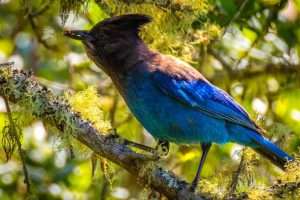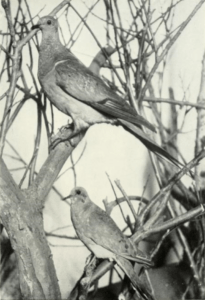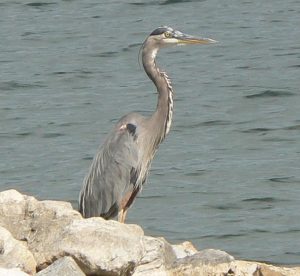 As fall migration begins, I’ve been watching the feeders outside my studio window to see how the cast of characters changes as the days pass. Today’s been relatively quiet, other than a juvenile American goldfinch (Spinus tristis) loudly hassling its father for food (in spite of the food being right there in front of it!)The black-headed grosbeaks (Pheucticus melanocephalus) haven’t been around for weeks, though they were never frequent visitors. The purple finches (Haemorhous purpureus) are beginning to thin out as well. The Steller’s jays (Cyanocitta stelleri), on the other hand, still happily show up for peanuts, and will imitate the local red-tailed hawks (Buteo jamaicensis) if they want to scare everyone off and have the feeder to themselves. But it gets me thinking about how more than just the migrating birds are missing.
As fall migration begins, I’ve been watching the feeders outside my studio window to see how the cast of characters changes as the days pass. Today’s been relatively quiet, other than a juvenile American goldfinch (Spinus tristis) loudly hassling its father for food (in spite of the food being right there in front of it!)The black-headed grosbeaks (Pheucticus melanocephalus) haven’t been around for weeks, though they were never frequent visitors. The purple finches (Haemorhous purpureus) are beginning to thin out as well. The Steller’s jays (Cyanocitta stelleri), on the other hand, still happily show up for peanuts, and will imitate the local red-tailed hawks (Buteo jamaicensis) if they want to scare everyone off and have the feeder to themselves. But it gets me thinking about how more than just the migrating birds are missing.
It Took Less Than a Lifetime
I was born in the late 1970s, and from a very young age I loved being outside. I was fortunate enough to live in suburbs and small towns where there was enough open land to support human-tolerant wildlife populations, and I spent countless hours exploring nearby woods and fields, as well as my own yard.
Birds, of course, were among the easiest animals to observe, and certainly the most visible vertebrates. My Midwestern home was full of American robins (Turdus migratorius), blue jays (Cyanocitta cristata), mourning doves (Zenaida macroura), and numerous other species. They sang in the trees and on power lines, searched for food in the yard, flew overhead, and occasionally–sadly–ended up deceased due to cars, cats, or unknown natural causes.
I haven’t lived there for many years, having since sojourned in other places and ending up living in several locations in the Pacific Northwest. So I don’t have a good firsthand comparison of population numbers from childhood versus today, at least not involving a single site. Thankfully there have been more methodical and thorough assessments of the changes in population numbers, but unfortunately the news isn’t good.
Three Billion Birds Are Missing
A 2019 study showed that the cumulative number of breeding individual birds in North America has dropped by 2.9 billion in the past fifty years, just a little longer than my own lifetime. If we assume that the sex ratio is roughly 50-50, and we optimistically assume that the bulk of these birds would have been able to find mates if they existed, then we’re probably looking at over a billion fewer nests of eggs being incubated each year. Even if we look at the standard estimate that 2/3 of nestlings won’t survive to breeding age, that’s still over 300 million babies that would have made it into the breeding populations of their species–if they existed, that is.
 Now, obviously, we didn’t lose all of them at once. Rather, this is a comparison of the total number of wild native birds of all species found in North America fifty years ago, versus the total number now. Even with normal population fluctuations due to environmental pressures, expected mortality levels, and so forth, the fact that we are seeing millions fewer birds is concerning. And it’s not just affecting rare species, but even the most common ones we’re used to seeing in large numbers.
Now, obviously, we didn’t lose all of them at once. Rather, this is a comparison of the total number of wild native birds of all species found in North America fifty years ago, versus the total number now. Even with normal population fluctuations due to environmental pressures, expected mortality levels, and so forth, the fact that we are seeing millions fewer birds is concerning. And it’s not just affecting rare species, but even the most common ones we’re used to seeing in large numbers.
(Incidentally, September 1 marked the 108th anniversary of the death of Martha, the very last passenger pigeon (Ectopistes migratorius), a species that dropped from an estimated population of 3-5 billion to zero in less than half a century. Sound familiar?)
What Happened To Them, and What Can We Do About It?
There are several factors that are contributing to the rapid decline in bird populations overall:
- Habitat loss and fragmentation is the single largest cause of species endangerment and extinction. Species can weather quite a lot of other pressures if they have places they can live in or migrate to. Buildings and roads, agriculture, mining, logging, and other human activities have chewed up about half of the land on the planet, and usually use the best and most fertile place first. This leaves many species–birds included–to try to scratch out a living in sub-par habitats, or go extinct trying. Habitat preservation and restoration are crucial to making sure that our birds and other wildlife are able to survive and thrive amid the various ecological pressures we’ve put on them.
- However, when it comes to birds in particular, it turns out that outdoor cats are likely the single biggest cause of human-generated mortality. How many birds are missing due to cats? Estimates vary from 1.3 billion to 4 billion birds and 6.3 billion to 22.3 billion mammals killed by cats every single year in the United States alone, while Canada sees annual losses of 76 million to 418 million birds due to cat predation. Cats are responsible for driving over five dozen species of bird and other animal to extinction. This isn’t just a matter of “nature taking its course.” Domesticated cats are a distinct species from their wild ancestors; as they did not evolve in a single ecosystem over many thousands or millions of years in balance with other species, they are not native to any ecosystem anywhere. Therefore, they throw off the balance of any ecosystem to which they are introduced, whether they are pets allowed to roam free, or colonies of feral cats. In fact, in some places they’ve been classified as invasive species. The push to spay and neuter cats doesn’t just help avoid unwanted litters of kittens, but also reduces the number of cats hunting birds and other wildlife. And the simple act of keeping pet cats indoors, unless on a harness and leash or in a catio, is an incredibly impactful action that can save numerous wildlife lives every year.
- Window strikes are another common human-related cause of bird mortality, killing 100 million birds in the United States every year. Since many birds migrate at night, lights on buildings and through windows can disorient them and cause a fatal crash. Birds can’t tell that glass is solid, and try to fly through. Those bird-shaped decals won’t work, as smaller birds will just try to fly through the spaces between them, like flying through small gaps in foliage. Instead, put up a window film with a close-knit grid of thin lines or dots, or hang a netting just outside the window (be careful that the birds can’t get tangled in it.) At night, close blinds and curtains, turn off any lights not in use, and switch your outdoor lights to motion-activated ones.
- The US Fish and Wildlife Service estimates that 72 million birds die of poison every year. This includes but is not limited to lead shot (a common killer of raptors and other scavengers who eat it), pesticides and other agricultural/lawn chemicals, and secondary poisoning through rodenticides. Switching to non-lead shot when hunting, and reducing or eliminating use of other poisons, all can help preserve bird populations. If birds are missing due to improper use and storage of these chemicals, then being more careful will be a boon to them.
 If I’m lucky, I’m only halfway through my lifetime. I would love to see this downward trend reversed. Even if my twilight years won’t show me the same numbers of birds as my childhood, I’ll count myself fortunate if on my last day I’ll no longer have to say that quite so many birds are missing from our bright, beautiful, biodiverse world.
If I’m lucky, I’m only halfway through my lifetime. I would love to see this downward trend reversed. Even if my twilight years won’t show me the same numbers of birds as my childhood, I’ll count myself fortunate if on my last day I’ll no longer have to say that quite so many birds are missing from our bright, beautiful, biodiverse world.
